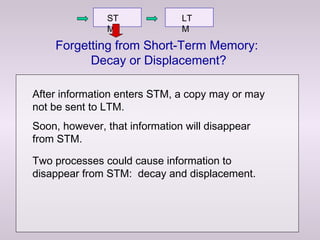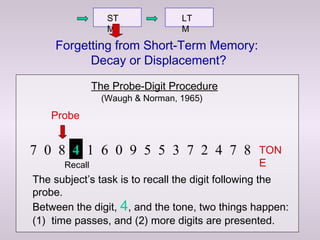Waugh norman65
- 1. Forgetting from Short-Term Memory: Decay or Displacement? ST M LT M After information enters STM, a copy may or may not be sent to LTM. Soon, however, that information will disappear from STM. Two processes could cause information to disappear from STM: decay and displacement.
- 2. Forgetting from Short-Term Memory: Decay or Displacement? ST M LT M Decay: information that is not rehearsed disappears as time passes. Displacement: information being held in STM is pushed out by newly arriving information. Displacement is most likely to occur when the capacity limit of STM has been reached (about 7 units of information).
- 3. Forgetting from Short-Term Memory: Decay or Displacement? ST M LT M Displacement is most likely to occur when the capacity limit of STM has been reached (about 7 units of information). R D Q L T H JB
- 4. Forgetting from Short-Term Memory: Decay or Displacement? ST M LT M Displacement is most likely to occur when the capacity limit of STM has been reached (about 7 units of information). B R D Q L T H J
- 5. Forgetting from Short-Term Memory: Decay or Displacement? ST M LT M The original version of the Atkinson-Shiffrin model emphasized decay as the main cause of forgetting in STM. Their later version emphasized displacement. Here is a study that compared decay to displacement and showed a much greater effect of displacement. B R D Q L T H J
- 6. Forgetting from Short-Term Memory: Decay or Displacement? ST M LT M The Probe-Digit Procedure You are read a list of 16 digits: (Waugh & Norman, 1965) 7 0 8 4 1 6 0 9 5 5 3 7 2 4 7 8 After the last digit, you hear a tone... TON E
- 7. Forgetting from Short-Term Memory: Decay or Displacement? ST M LT M The Probe-Digit Procedure (Waugh & Norman, 1965) 7 0 8 4 1 6 0 9 5 5 3 7 2 4 7 8 The tone is a signal to recall one of the digits. The last digit before the tone (8) occurs only once at an earlier point in the list. TON E This is called the “probe”. Probe
- 8. Forgetting from Short-Term Memory: Decay or Displacement? ST M LT M The Probe-Digit Procedure (Waugh & Norman, 1965) 7 0 8 4 1 6 0 9 5 5 3 7 2 4 7 8 The subject’s task is to recall the digit following the probe. TON E Between the digit, 4, and the tone, two things happen: (1) time passes, and (2) more digits are presented. Probe 4 Recall
- 9. Forgetting from Short-Term Memory: Decay or Displacement? ST M LT M The Probe-Digit Procedure (Waugh & Norman, 1965) 7 0 8 4 1 6 0 9 5 5 3 7 2 4 7 8 Which is more important in causing forgetting, time or the additional digits? TON E Probe 4 Recall The decay principle implies time; the displacement principle implies digits.
- 10. Forgetting from Short-Term Memory: Decay or Displacement? ST M LT M The Probe-Digit Procedure (Waugh & Norman, 1965) 7 0 8 4 1 6 0 9 5 5 3 7 2 4 7 8 Time and digits are correlated (confounded). To separate them, Waugh & Norman used two rates of presentation: slow (1 digit per second) and fast (4 digits per second). TON E Probe 4 Recall +1+ 1 +1 +1 + 1 +1+ 1+ 1+ 1+ 1 +1 +1 = 12 Slow Presentation (Seconds)
- 11. Forgetting from Short-Term Memory: Decay or Displacement? ST M LT M The Probe-Digit Procedure (Waugh & Norman, 1965) 7 0 8 4 1 6 0 9 5 5 3 7 2 4 7 8 More time passes between the digit and the tone with slow presentation (12 seconds) than with fast presentation (3 seconds). According to the decay principle, the chances of recalling the digit should be lower with slow than with fast presentation. TON E Probe 4 Fast Presentation (Seconds) 1 + 1 + 1 = 3
- 12. Forgetting from Short-Term Memory: Decay or Displacement? ST M LT M The Probe-Digit Procedure (Waugh & Norman, 1965) 7 0 8 4 1 6 0 9 5 5 3 7 2 4 7 8 According to the displacement principle, the chances of recalling the digit should be the same with fast and slow presentation because the number of digits before the tone is the same in both conditions. TON E Probe 4 Fast Presentation (Seconds) 1 + 1 + 1 = 3
- 13. Forgetting from Short-Term Memory: Decay or Displacement? ST M LT M The Probe-Digit Procedure (Waugh & Norman, 1965) 7 0 8 4 1 6 0 9 5 5 3 7 2 4 7 8 Waugh & Norman made this comparison with the probe digit in each of the following positions: 3 (shown here), 5, 7, 9, 10, 12, 13, or 14. TON E Probe 4 Fast Presentation (Seconds) 1 + 1 + 1 = 3 Both decay and displacement predict an increase in recall as the probe gets closer to the tone.
- 14. Forgetting from Short-Term Memory: Decay or Displacement? ST M LT M The Probe-Digit Procedure (Waugh & Norman, 1965) 7 0 8 4 1 6 0 9 5 5 3 7 2 4 7 8 There was slightly (but not significantly) higher recall with fast than with slow presentation when the probe was near the beginning of the list. Recall dropped sharply as the probe was moved from the end toward the beginning. TON E Probe 4 Fast Presentation (Seconds) 1 + 1 + 1 = 3 Results
- 15. Forgetting from Short-Term Memory: Decay or Displacement? ST M LT M The Probe-Digit Procedure (Waugh & Norman, 1965) 7 0 8 4 1 6 0 9 5 5 3 7 2 4 7 8 As time passes, what mainly causes forgetting from short-term memory is exposure to additional information, not the passage of time. TON E Probe 4 Fast Presentation (Seconds) 1 + 1 + 1 = 3 Conclusion















